SAIC Motor Corporation Bundle
How Did SAIC Motor Corporation Become a Global Automotive Powerhouse?
SAIC Motor Corporation, a dominant force in the global automotive industry, showcases China's impressive economic growth and strategic industrial leadership. Its journey from a modest beginning to a global giant highlights remarkable growth, innovation, and international expansion. This evolution mirrors the transformation of China's automotive sector and the shifts in the global car market.
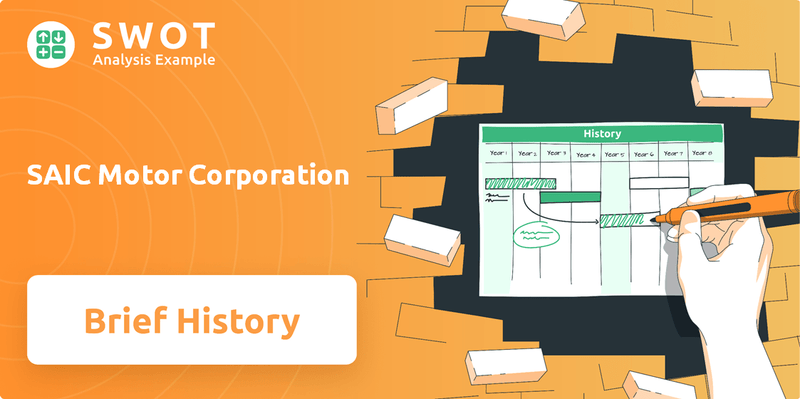
Today, SAIC Motor, formerly known as Shanghai Automotive Industry Corporation, boasts a significant market position, ranking among the world's largest automotive manufacturers. Understanding the SAIC Motor Corporation SWOT Analysis is crucial to grasping its strategic moves. This exploration will cover the SAIC history, tracing its path from its founding to its current status as a global automotive leader, examining key milestones and the challenges it faced.
What is the SAIC Motor Corporation Founding Story?
The SAIC Motor Corporation's story begins in 1955, marking a significant era in the Chinese automotive industry. Initially, it was established as the Shanghai Diesel Engine Parts Manufacturing Company. This marked the beginning of what would become a major player in the global automotive market.
The founding of SAIC history was a direct response to China's post-revolutionary push for industrial development and self-sufficiency. The primary goal was to support the growing automotive and machinery sectors. This strategic move set the stage for future vehicle production and the expansion of SAIC brands.
SAIC Motor Corporation, formerly the Shanghai Diesel Engine Parts Manufacturing Company, was established in 1955. It was a key part of China's national industrialization strategy.
- The company focused on manufacturing engine parts.
- The economic context involved China's drive to reduce reliance on foreign imports.
- The initial vision was to create a strong domestic manufacturing base.
- The establishment aimed to build a complete automotive supply chain.
SAIC Motor Corporation SWOT Analysis
- Complete SWOT Breakdown
- Fully Customizable
- Editable in Excel & Word
- Professional Formatting
- Investor-Ready Format
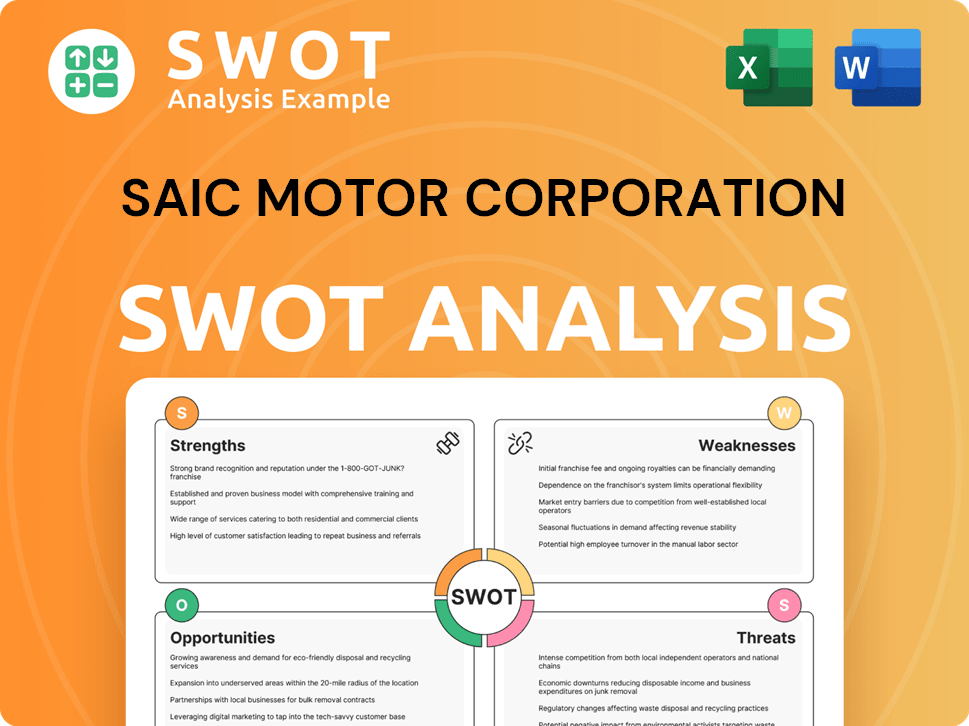
What Drove the Early Growth of SAIC Motor Corporation?
The early growth of SAIC Motor Corporation was marked by strategic expansion beyond its initial focus. A key move was the establishment of joint ventures, such as the one with Volkswagen in 1984, which formed Shanghai Volkswagen Automotive Co., Ltd. This partnership allowed SAIC history to enter passenger car manufacturing and gain access to foreign technology. These collaborations were vital for SAIC company to grow in the Chinese automotive market.
In 1984, SAIC Motor Corporation partnered with Volkswagen, forming Shanghai Volkswagen Automotive Co., Ltd. This joint venture was crucial for entering the passenger car market. In 1997, SAIC Motor Corporation also formed a joint venture with General Motors, creating SAIC-GM. These partnerships helped SAIC absorb international expertise.
The Santana, produced through the Shanghai Volkswagen joint venture, became highly popular in China. These early products drove significant sales milestones for the SAIC company. This success laid the groundwork for future independent brand development. The early success of the Santana highlighted the potential of the Owners & Shareholders of SAIC Motor Corporation.
During this period, SAIC Motor Corporation expanded its production capacity. The company also invested in research and development capabilities. This expansion was crucial for supporting the growth of the Chinese automotive industry. These efforts helped SAIC brands establish a strong presence.
The early growth phase saw SAIC Motor Corporation expand its team. Sophisticated manufacturing facilities were established across China. This expansion of facilities and workforce supported the company's rapid growth. This expansion prepared SAIC Motor Corporation for future challenges.
SAIC Motor Corporation PESTLE Analysis
- Covers All 6 PESTLE Categories
- No Research Needed – Save Hours of Work
- Built by Experts, Trusted by Consultants
- Instant Download, Ready to Use
- 100% Editable, Fully Customizable
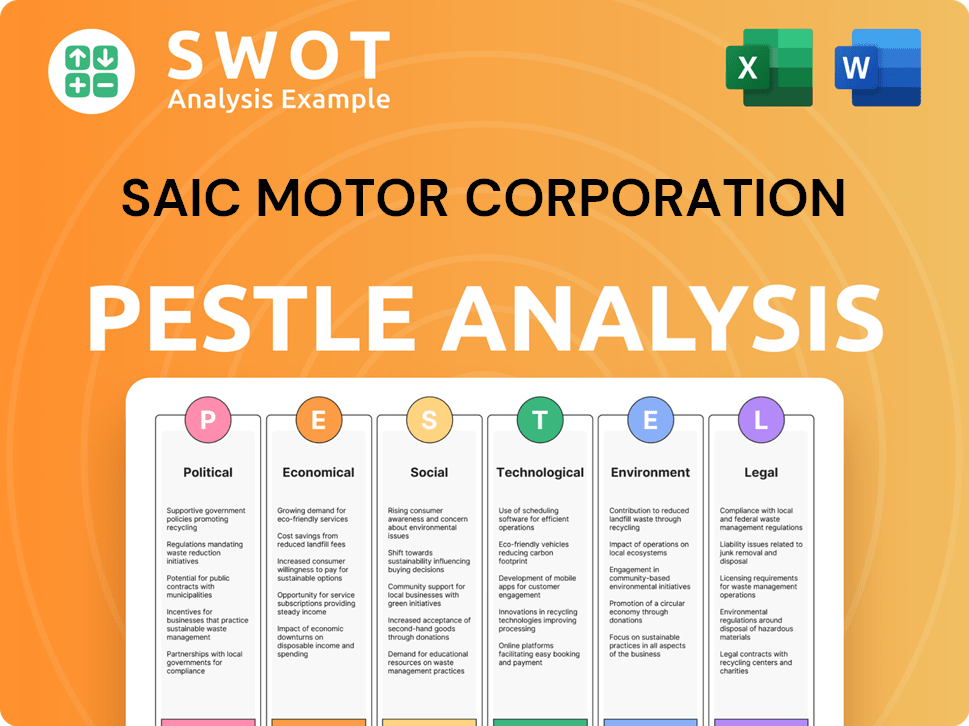
What are the key Milestones in SAIC Motor Corporation history?
The SAIC Motor Corporation has a rich SAIC history, marked by strategic moves and significant growth within the Chinese automotive industry. The journey of SAIC Motor Corporation, from its origins to its current status, showcases its evolution and its impact on the global market. The company's ability to adapt and innovate has been key to its success.
| Year | Milestone |
|---|---|
| 2006 | Launched its own independent brand, Roewe, marking a shift towards proprietary brands. |
| 2007 | Acquired the British brand MG, expanding its global presence and product portfolio. |
| 2014 | SAIC Motor Corporation's sales exceeded 5 million vehicles, a significant achievement. |
| 2020 | SAIC Motor delivered over 5.6 million vehicles, despite global challenges. |
| 2023 | SAIC Motor sold around 5.02 million vehicles, demonstrating its market position. |
SAIC Motor Corporation has been at the forefront of innovation, particularly in the realm of new energy vehicles (NEVs). The company has invested heavily in intelligent connected vehicles and autonomous driving technologies, showcasing its commitment to future mobility.
SAIC Motor Corporation has significantly invested in new energy vehicles (NEVs), becoming a leading player in China's EV market.
The company is making strides in intelligent connected vehicles, integrating advanced technologies for enhanced user experience.
SAIC Motor Corporation is actively developing autonomous driving technologies, aiming to integrate these features into its vehicles.
The company consistently increases R&D spending to foster innovation in the automotive sector.
SAIC Motor Corporation focuses on expanding its global footprint, increasing its presence in international markets.
The company has been involved in strategic restructuring to improve efficiency and adapt to market changes.
SAIC Motor Corporation faces several challenges, including intense competition in the Chinese market and global economic fluctuations. The transition to NEVs requires substantial investment and market adaptation, impacting the SAIC company's strategic direction. For a deeper dive into the company's values, consider reading about the Mission, Vision & Core Values of SAIC Motor Corporation.
SAIC Motor Corporation faces intense competition from both domestic and international players within the Chinese market.
Global economic fluctuations pose challenges, affecting sales and market strategies.
The shift towards new energy vehicles (NEVs) requires significant technological and market adaptation.
The need for continuous investment in research and development to stay competitive is a constant challenge.
Navigating the complexities of global market dynamics, including trade policies and consumer preferences, presents ongoing hurdles.
Supply chain disruptions and material costs pose challenges to production and profitability.
SAIC Motor Corporation Business Model Canvas
- Complete 9-Block Business Model Canvas
- Effortlessly Communicate Your Business Strategy
- Investor-Ready BMC Format
- 100% Editable and Customizable
- Clear and Structured Layout
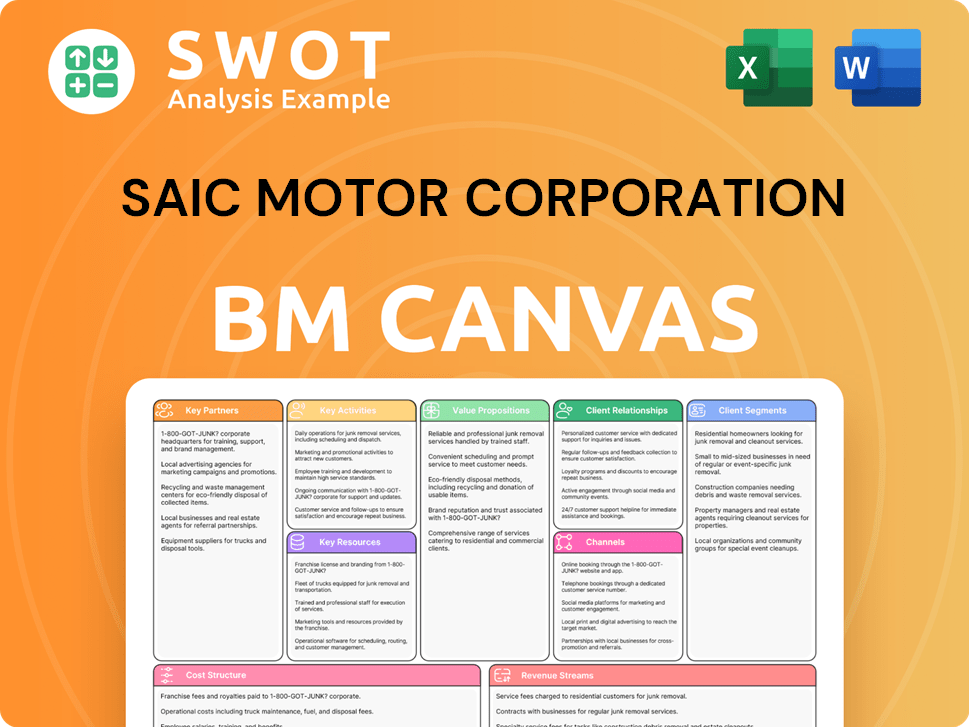
What is the Timeline of Key Events for SAIC Motor Corporation?
The SAIC Motor Corporation, a key player in the Chinese automotive industry, has a rich history marked by strategic partnerships and technological advancements. From its origins as a diesel engine parts manufacturer to its current status as a global automotive leader, SAIC's journey reflects the evolution of the Chinese automotive sector. The company's timeline is punctuated by significant events that have shaped its growth and market position, establishing it as a major force in the industry.
| Year | Key Event |
|---|---|
| 1955 | Founded as Shanghai Diesel Engine Parts Manufacturing Company, marking the beginning of SAIC's journey. |
| 1984 | Established a joint venture with Volkswagen, setting the stage for future international collaborations. |
| 1997 | Formed a joint venture with General Motors, expanding its global reach and technological capabilities. |
| 2006 | Launched the independent brand Roewe, reflecting its commitment to developing its own brand portfolio. |
| 2007 | Acquired the MG brand, enhancing its international presence and brand diversity. |
| 2010s | Made significant investments in new energy vehicle (NEV) development, preparing for the future of the automotive industry. |
| 2020s | Continued global expansion, particularly in Europe and Southeast Asia, increasing its international market share. |
| 2023 | Achieved sales of approximately 5.02 million vehicles, demonstrating its strong market position. |
| 2024 | Announced a target of selling 1.34 million NEVs in 2025, emphasizing its focus on sustainable mobility. |
SAIC Motor is heavily focused on accelerating its transition to new energy vehicles and intelligent connected vehicles. This strategic shift is a key component of the company's future growth plans. The company is investing in advanced technologies like solid-state batteries and autonomous driving. This positions them at the forefront of automotive innovation, aiming to meet future market demands and maintain a competitive edge.
The company aims for substantial overseas sales, targeting 1.5 million vehicle sales outside of China by 2025. This expansion includes a focus on key markets like Europe, where they are establishing a presence with their NEV offerings. This global approach is crucial for SAIC's long-term growth and market diversification, helping it to navigate regional market dynamics and increase its overall sales volume.
SAIC is investing heavily in advanced technologies such as solid-state batteries and autonomous driving. These investments are critical for maintaining a competitive edge in the rapidly evolving automotive industry. The company's focus on innovation aligns with the global shift towards sustainable and intelligent mobility solutions. This ensures SAIC remains relevant and competitive.
Analyst predictions suggest that SAIC's continued focus on NEVs and international expansion will be critical for its future growth. The automotive market is highly competitive, and SAIC must navigate challenges effectively. Its ability to adapt to changing market conditions and maintain a strong brand presence will be key to its success. This includes focusing on sustainable and intelligent mobility.
SAIC Motor Corporation Porter's Five Forces Analysis
- Covers All 5 Competitive Forces in Detail
- Structured for Consultants, Students, and Founders
- 100% Editable in Microsoft Word & Excel
- Instant Digital Download – Use Immediately
- Compatible with Mac & PC – Fully Unlocked
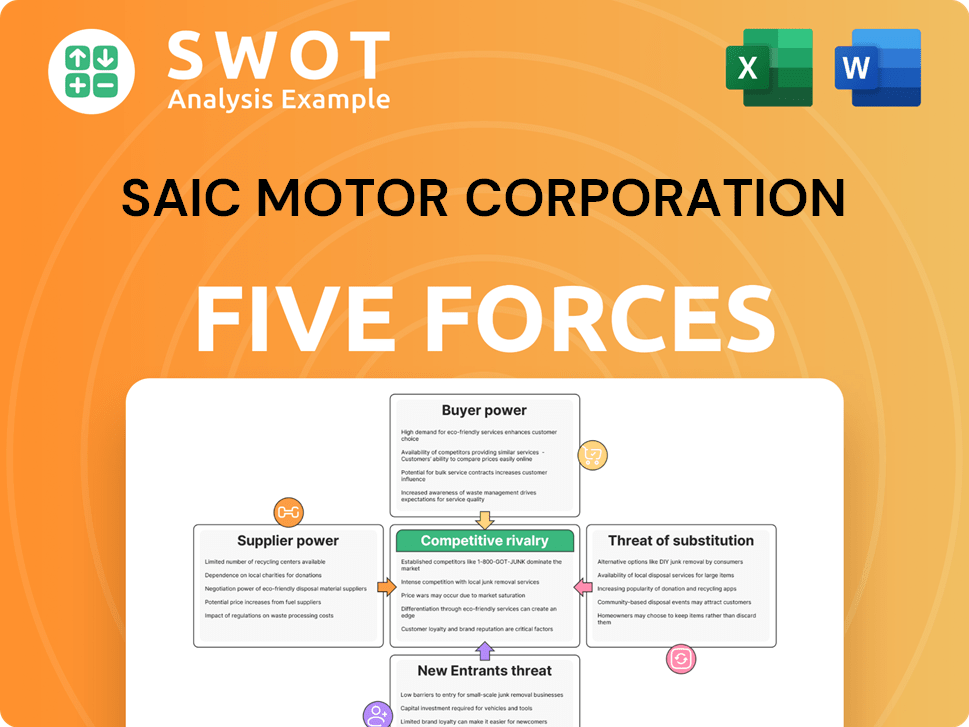
Related Blogs
- What is Competitive Landscape of SAIC Motor Corporation Company?
- What is Growth Strategy and Future Prospects of SAIC Motor Corporation Company?
- How Does SAIC Motor Corporation Company Work?
- What is Sales and Marketing Strategy of SAIC Motor Corporation Company?
- What is Brief History of SAIC Motor Corporation Company?
- Who Owns SAIC Motor Corporation Company?
- What is Customer Demographics and Target Market of SAIC Motor Corporation Company?
Disclaimer
All information, articles, and product details provided on this website are for general informational and educational purposes only. We do not claim any ownership over, nor do we intend to infringe upon, any trademarks, copyrights, logos, brand names, or other intellectual property mentioned or depicted on this site. Such intellectual property remains the property of its respective owners, and any references here are made solely for identification or informational purposes, without implying any affiliation, endorsement, or partnership.
We make no representations or warranties, express or implied, regarding the accuracy, completeness, or suitability of any content or products presented. Nothing on this website should be construed as legal, tax, investment, financial, medical, or other professional advice. In addition, no part of this site—including articles or product references—constitutes a solicitation, recommendation, endorsement, advertisement, or offer to buy or sell any securities, franchises, or other financial instruments, particularly in jurisdictions where such activity would be unlawful.
All content is of a general nature and may not address the specific circumstances of any individual or entity. It is not a substitute for professional advice or services. Any actions you take based on the information provided here are strictly at your own risk. You accept full responsibility for any decisions or outcomes arising from your use of this website and agree to release us from any liability in connection with your use of, or reliance upon, the content or products found herein.